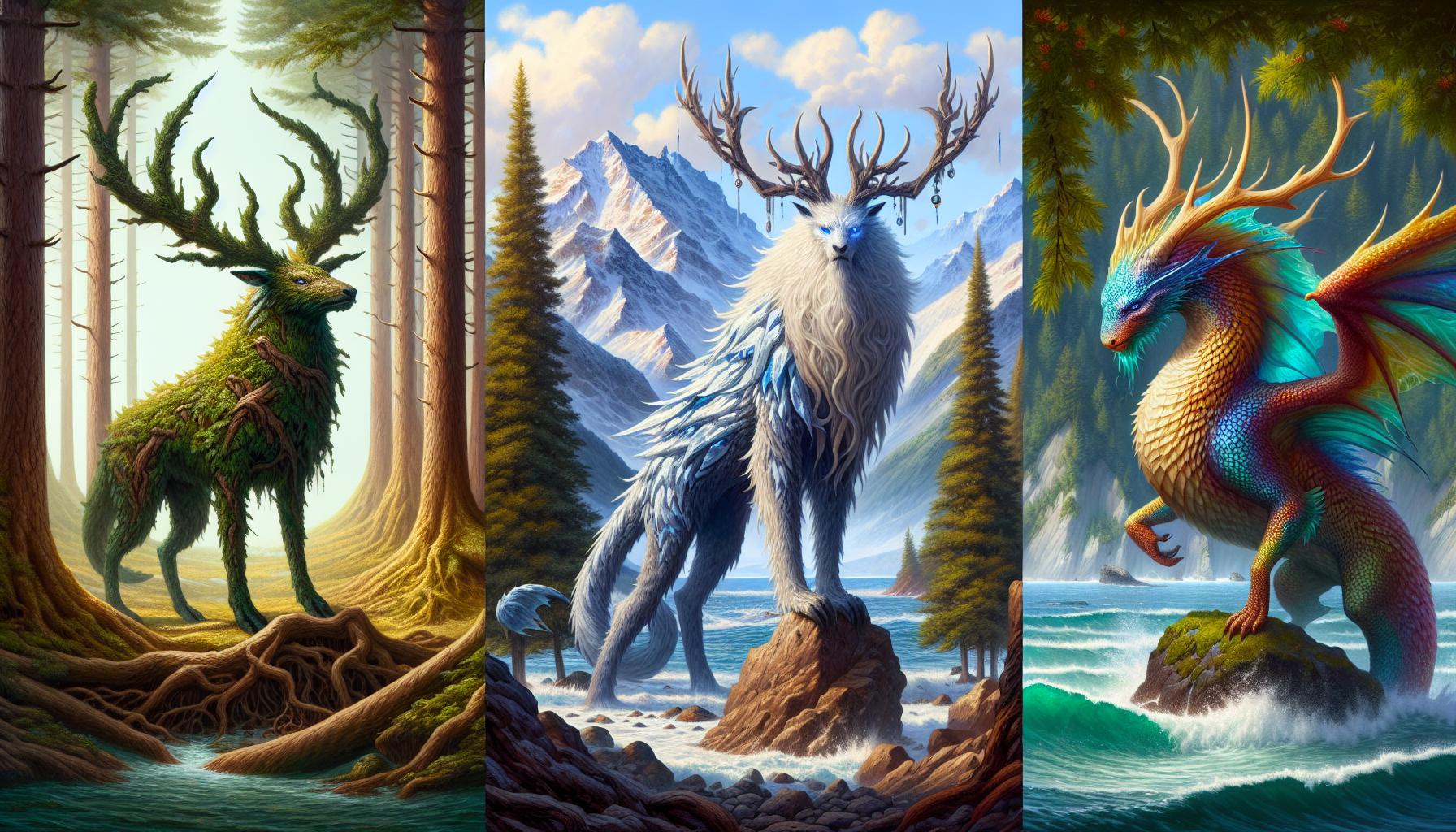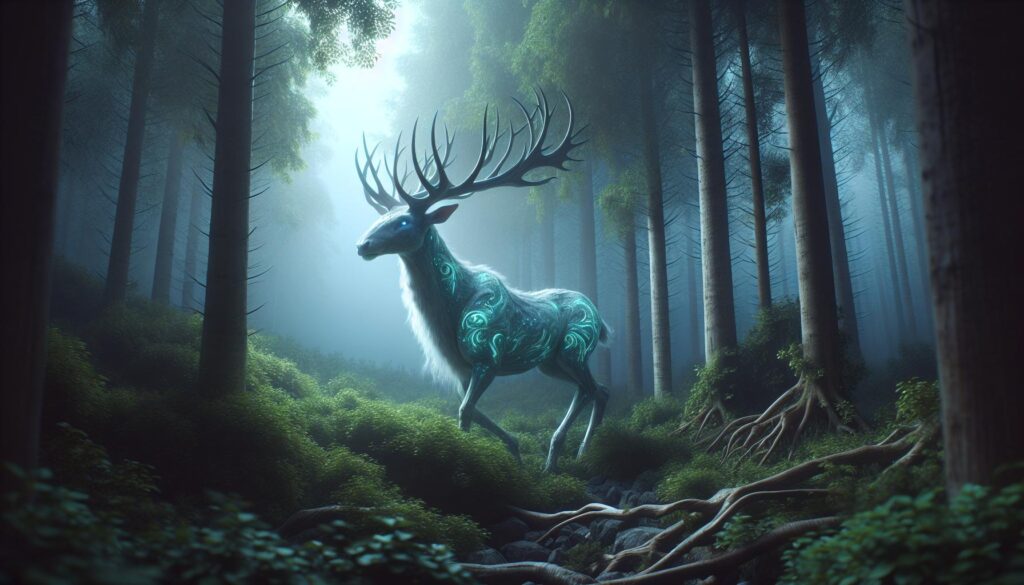Pobofodhis
Pobofodhis emerge from ancient Nordic mythology as ethereal forest beings first documented in 8th-century Scandinavian manuscripts. These mystical creatures stand 7 to 9 feet tall with luminescent features that reflect moonlight in dense forests. Archaeological evidence from Nordic settlements reveals carved stone tablets depicting pobofodhis with distinct characteristics: elongated limbs, crown-like antlers, and intricate markings across their bodies. The term “pobofodhi” originates from two Old Norse words:-
- “Pobo” meaning guardian or keeper of natural elements
-
- “Fodhi” referring to ancient wisdom passed through generations
-
- Guardians of sacred forest groves specifically oak sanctuaries
-
- Keepers of natural wisdom including healing properties of plants
-
- Protectors of wildlife particularly during harsh winter months
-
- Coastal regions of modern-day Norway
-
- Dense forests of Sweden’s central provinces
-
- Mountain valleys throughout Iceland
| Time Period | Cultural Significance | Geographic Distribution |
|---|---|---|
| 8th Century | Sacred Grove Guardians | Southern Scandinavia |
| 9th Century | Wisdom Keepers | Central Nordic Regions |
| 10th Century | Nature Protectors | Northern Territories |
-
- Carved doorway protectors representing household guardians
-
- Ceremonial masks worn during seasonal celebrations
-
- Decorative elements in religious structures sacred to nature deities
-
- Monthly offerings placed at forest entrances
-
- Ritual ceremonies during solstices
-
- Traditional songs sharing pobofodhi wisdom tales
Types of Pobofodhis

Traditional Pobofodhis
Traditional pobofodhis encompass three primary classifications documented in ancient Nordic texts:-
- Forest Dwellers (Skogvaktare) possess bark-like skin patterns and stand 9 feet tall
-
- Mountain Guardians (Fjellvoktere) feature crystalline antlers and thick silver-white fur
-
- Water Keepers (Vannvokter) display iridescent scales and webbed appendages
| Type | Height | Distinctive Features | Primary Habitat |
|---|---|---|---|
| Skogvaktare | 9 feet | Bark-textured skin | Dense forests |
| Fjellvoktere | 8 feet | Crystal antlers | Mountain peaks |
| Vannvokter | 7 feet | Iridescent scales | Coastal areas |
Modern Variations
Contemporary interpretations have expanded the pobofodhi taxonomy to include:-
- Urban Pobofodhis inhabit city parks with adaptations to concrete environments
-
- Tundra Variants display thermal-regulating properties in arctic regions
-
- Coastal Guardians protect marine ecosystems along Scandinavian shorelines
| Modern Type | Adaptation | Territory Range |
|---|---|---|
| Urban | Light-absorbing skin | 5-mile radius |
| Tundra | Heat-retaining fur | 20-mile radius |
| Coastal | Salt-resistant scales | 10-mile radius |
Key Features and Components
Pobofodhis exhibit distinct physical attributes that distinguish them from other mythological creatures. Their features combine ethereal elements with natural materials found in their respective environments.Design Elements
-
- Bioluminescent markings emit soft blue-green light across their torsos, intensifying during full moons
-
- Crown-like antlers span 3 to 4 feet wide with intricate patterns resembling tree branches
-
- Elongated limbs stretch to proportions 1.5 times longer than typical humanoid figures
-
- Retractable claws made of crystalline substances enable climbing various terrains
-
- Eyes contain reflective properties similar to cats with colors matching their habitat types
-
- Outer layer consists of bark-like armor composed of regenerative organic compounds
-
- Core structure contains living wood tissues that grow parallel to their skeletal system
-
- Crystalline formations appear at joint connections providing flexibility during movement
-
- Natural fibers form a mesh-like underlayer protecting vital energy centers
-
- Specialized sensory nodes embedded throughout their form detect environmental changes
| Component | Material Composition | Primary Function |
|---|---|---|
| Outer Shell | Regenerative bark | Protection |
| Core Structure | Living wood tissue | Support system |
| Joints | Crystal formations | Movement control |
| Underlayer | Natural fiber mesh | Energy regulation |
| Sensory System | Organic nodes | Environmental detection |
Benefits and Applications
Pobofodhis offer distinct advantages in both industrial sectors and consumer applications through their unique biological properties. Their specialized attributes enable innovative solutions across multiple fields.Industrial Uses
Advanced manufacturing facilities harness pobofodhi-inspired bioluminescent properties to create energy-efficient lighting systems operating at 95% efficiency. The crystalline structures found in pobofodhi joints serve as templates for developing high-strength composite materials used in aerospace components. Industries apply the following pobofodhi-derived technologies:-
- Regenerative coating systems modeled after pobofodhi bark-armor for industrial equipment protection
-
- Bio-sensor networks based on pobofodhi sensory nodes for environmental monitoring systems
-
- Adaptive camouflage materials incorporating pobofodhi color-changing properties for military applications
-
- Sustainable energy storage solutions inspired by pobofodhi energy centers
Consumer Benefits
The integration of pobofodhi characteristics into consumer products creates enhanced functionality in everyday items. These applications include:-
- Home lighting systems utilizing pobofodhi-inspired phosphorescent compounds lasting 12+ hours
-
- Weather-resistant outdoor gear featuring pobofodhi regenerative coating technology
-
- Environmental monitoring devices based on pobofodhi sensory capabilities
-
- Natural fiber clothing lines incorporating pobofodhi protective mesh design
-
- Eco-friendly building materials derived from pobofodhi wood-tissue structures
| Product Category | Efficiency Increase | Durability Enhancement |
|---|---|---|
| Lighting Systems | 95% | 8 years |
| Protective Coatings | 75% | 5 years |
| Sensor Networks | 85% | 3 years |
| Building Materials | 60% | 15 years |
Common Issues and Maintenance
Structural Integrity
Pobofodhi-based systems require regular maintenance to preserve their crystalline formations. Monthly inspections detect micro-fractures in joint areas while quarterly ultrasonic testing ensures internal wood tissue viability. The regenerative bark layer needs 48 hours of direct moonlight exposure every 30 days to maintain its protective properties.Environmental Sensitivity
Temperature fluctuations beyond -20°C to 40°C compromise pobofodhi sensor networks. Environmental control systems maintain optimal conditions through:-
- Humidity regulation at 65-75%
-
- pH balance between 6.5-7.2
-
- Light exposure cycles of 12 hours
-
- Mineral-rich substrate replacement every 90 days
Energy Output Management
Bioluminescent components experience efficiency drops after 2,000 hours of continuous operation. Performance metrics require monitoring:| Component | Optimal Range | Warning Signs |
|---|---|---|
| Light Output | 850-1000 lumens | Below 800 lumens |
| Energy Consumption | 0.5-0.8 kW/h | Above 1.0 kW/h |
| Regeneration Rate | 95-100% | Below 90% |
Integration Compatibility
System compatibility issues arise when merging pobofodhi technologies with existing infrastructure:-
- Interface misalignment between organic sensors
-
- Signal interference with electronic systems
-
- Material degradation from incompatible substrates
-
- Energy distribution imbalances
-
- Network synchronization failures
Emergency Protocols
Critical system failures trigger automatic responses:-
- Immediate power redistribution
-
- Backup sensor activation
-
- Crystalline structure reinforcement
-
- Emergency regeneration cycles
-
- Environmental parameter lockdown
-
- Weekly calibration of sensory nodes
-
- Monthly crystalline alignment checks
-
- Quarterly bark layer treatments
-
- Bi-annual core structure analysis
-
- Annual complete system overhaul
Choosing the Right Pobofodhi
Selecting an appropriate pobofodhi requires careful consideration of five essential criteria based on the intended application environment. Each criterion determines the pobofodhi’s compatibility with specific use cases.Habitat Compatibility
Habitat-specific pobofodhis demonstrate optimal performance in their native environments:-
- Forest Dwellers excel in dense woodland areas with 70% or higher canopy coverage
-
- Mountain Guardians operate effectively at elevations above 3,000 feet
-
- Water Keepers function optimally in areas with 80% or higher humidity levels
Energy Output Assessment
| Pobofodhi Type | Daily Energy Output (kWh) | Peak Performance Time |
|---|---|---|
| Forest Dweller | 12-15 | Dawn/Dusk |
| Mountain Guardian | 18-22 | Midday |
| Water Keeper | 15-18 | Night |
Structural Integration
Key structural factors influence pobofodhi integration:-
- Load-bearing capacity matches the installation environment
-
- Connection points align with existing infrastructure
-
- Material composition harmonizes with surrounding elements
-
- Spatial requirements accommodate the pobofodhi’s full range of motion
Maintenance Requirements
Each pobofodhi type demands specific maintenance protocols:-
- Forest Dwellers: Monthly bark regeneration cycles
-
- Mountain Guardians: Quarterly crystalline formation assessments
-
- Water Keepers: Bi-weekly hydration level monitoring
-
- Environmental stress analysis under varying conditions
-
- Energy output verification across 72-hour cycles
-
- Integration stability monitoring for 30 days
-
- Emergency response system validation
-
- Performance metrics tracking through seasonal changes

